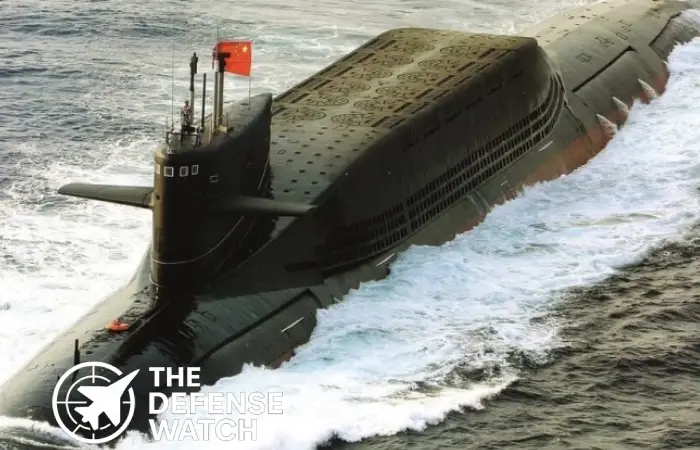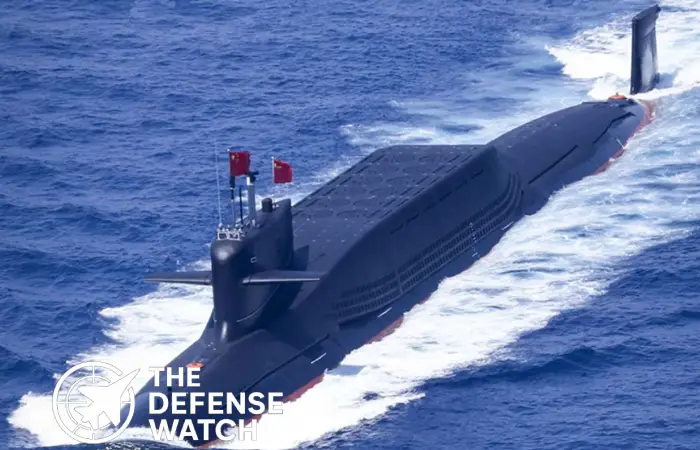The Type 094 (NATO reporting name “Jin-class”) nuclear-powered ballistic missile submarine has emerged as a central component of the People’s Liberation Army Navy’s (PLAN) sea-based nuclear deterrent. In recent public disclosures, China has revealed specifications and operations of the Type 094, while external analysts flag key limitations and broader strategic implications. This article examines the submarine’s operations, technical profile, and significance in the evolving Indo-Pacific maritime environment.
Background & Development
The Type 094 succeeds the earlier Type 092 (Xia-class) SSBN and precedes the next-generation Type 096 under development. The PLAN commissioned its first Type 094 in 2007 and by 2020 six units were reportedly active. According to the U.S. Department of Defense, the Type 094 constitutes China’s “first credible sea-based nuclear deterrent”.
Technical Features & Capabilities
Publicly released details in 2025 by Chinese authorities reveal significant information: the vessel is about 135 m long, has a submerged displacement of about 11,000 tonnes, a maximum depth of around 400 m, and a top speed near 30 knots.
Key armament includes up to 12 submarine-launched ballistic missiles (SLBMs) – originally the JL‑2 (range ~7,000 km) and more recently reportedly the JL‑3 (range >10,000 km) for continental U.S. reach.
Nevertheless, the class is assessed to have a relatively high acoustic signature compared to contemporary Western or Russian SSBNs, diminishing its stealth in contested waters.
Operational Deployment & Patrols
In recent months, China has publicly shown the Type 094 departing for extended patrols and disclosed performance data during the PLAN’s open-day events. According to reporting, their region of operations includes the South China Sea and littoral zones near Hainan Island.
These deployments underscore a transition from purely regional deterrence to a more global sea-based nuclear posture. Analysts interpret the move as Beijing signaling an expanding second-strike capability.

Strategic Significance
From a strategic perspective, the Type 094 operations matter for several reasons:
- Broader nuclear triad: By deploying SSBNs like the Type 094, China adds survivable sea-based assets to its nuclear deterrent alongside land-based missiles and strategic bombers.
- Maritime influence projection: Operating from bases in the South China Sea, these submarines support China’s ability to assert maritime power and influence regional escalation dynamics.
- Regional deterrence calculus: Neighbours and external powers must factor in a Chinese second-strike submarine capability, complicating anti-submarine warfare (ASW) and strategic planning.
Limitations & Challenges
However, the Type 094 has notable constraints:
- Noise signature: Reports indicate that the class remains noisier than leading SSBNs, which reduces stealth and survivability in high-end ASW scenarios.
- Patrol zones: Evidence suggests China may still operate the class relatively close to home waters rather than distant deep-ocean patrols, limiting their stealth and reach advantage.
- Missile maturity: While the JL-3 upgrades improve range and MIRV capabilities, full operational integration and reliability remain subject to external verification.
Outlook & Context
Looking ahead, the planned Type 096 and upgraded missile systems will further enhance China’s SSBN fleet. Meanwhile, the Type 094 appears to be entering routine deterrent patrols, signalling Beijing’s evolving undersea strategy. For regional powers and the U.S., this trend will necessitate enhanced ASW capabilities, undersea domain awareness, and calibrated deterrence posture.
In sum, the deployment and operationalization of the Type 094 reflect both China’s ambitions and the evolving challenge of undersea strategic competition in the Indo-Pacific.
FAQs
The Type 094 conducts sea-based nuclear deterrent patrols (SSBN role), meaning it carries submarine-launched ballistic missiles and operates submerged to maintain a second-strike capability.
They are believed to be home-ported in bases such as the one on Hainan Island’s Longpo Naval Base, supporting patrols in the South China Sea and adjacent waters.
It is reported to have up to 12 missile tubes for SLBMs such as the JL-2 or JL-3.
Not yet. While the Type 094 provides China with a viable sea-based deterrent, analysts point to its higher acoustic signature and more constrained patrol area compared to the U.S. Ohio-class.
China is developing the Type 096 SSBN, which is expected to feature greater stealth, more missiles, and longer-range SLBMs.


6 comments
[…] geopolitics overlap. The event highlights how even in well-regulated allied waters, complex naval operations carry risk and demand careful coordination. The incident also underscores the growing prominence of […]
[…] compared to conventional manned submarines. Second, it contributes to the normalization of unmanned submarines in maritime deterrence, reducing the entry threshold for “advanced” navies. Third, as Indonesia sets up this capacity […]
[…] on the move, defense analysts highlight that the induction fulfils both operational and strategic objectives: upgrading capability and signaling greater procurement independence from […]
[…] Boeing, the end of the Boeing Defense strike removes a major near-term operational challenge but highlights broader industrial pressures—both labor and supply-chain—that continue to shape U.S. defense […]
[…] Types of vessels: A mix of naval ships and more than 1,000 fishing vessels, under a joint Maritime Partnership Program (MPP). […]
[…] such as the Dosan Ahn Chang-ho–class submarines, the transfer will enable Poland to enhance its undersea operational capacity at minimal acquisition […]